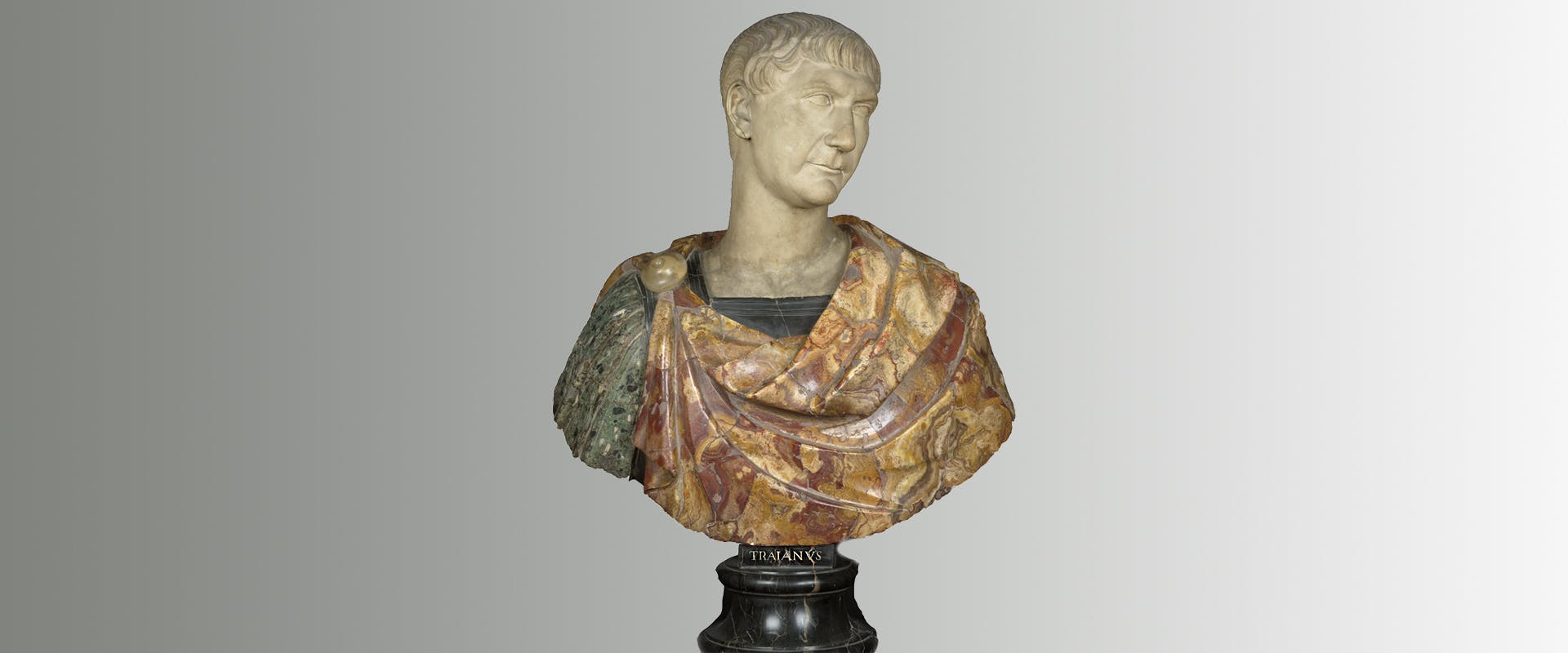Following in Trajan’s Footsteps
Following in Trajan’s Footsteps
This itinerary, inspired by the celebrations to commemorate the 1900th anniversary of Trajan’s death, is relevant again today, since it coincides with the opening of a new exhibition, “Building a Masterpiece: Trajan’s Column”, that will be held inside the Limonaia at Boboli Gardens from 21/06/2019 to 06/10/2019.
Trajan and Florence. This may seem like an unusual pairing, but there is a profound link that joins Trajan to the city. One that has lasted for centuries. In the 13th century, Dante included a Christian elaboration of Trajan’s story in his Divine Comedy, as interpreted in the post-classical age (Dante, Purgatorio X, 73-96; Paradiso XX, 43-48 and 106-117). The fourteenth-century frescoes in the Bardi Chapel inside the Dominican church of Santa Maria Novella contain a cycle of paintings dedicated to St Gregory the Great and re-evoking legends linked to the figure of Trajan. Several centuries later, prestigious marbles, recovered from ancient Roman monuments, became part of the collections of antiquities belonging to the Medici, especially those acquired by Ferdinando I, which joined the decorative sculptures in Villa Medici on the Pincio Hill before being moved to the Florentine properties of the Grand Duchy at the end of the 18th century.
The selected works being showcased in this HyperVision aim to be a natural continuation of the exhibition, giving visitors the possibility of recognising the precious relics and unique items from the reign of Trajan, which can be found in each museum of the Uffizi Galleries. From the Loggia dei Lanzi, to the Gallery of Statues and Paintings and then to the Boboli Gardens and the Palatine Gallery, the remains from Trajan's Forum in the state collections of Florence offer a selection of exceptional sculpted masterpieces, in terms of both number and quality, that are rarely equalled even in Rome.
Texts by Manola Giachi and Fabrizio Paolucci
Translation by Eurotrad snc.
Editing by Lorenzo Cosentino, Maria Anna Petricelli, Patrizia Naldini - Dipartimento di Informatica e Strategie Digitali
Photos by Francesco del Vecchio e Roberto Palermo (Dipartimento Fotografico)
Published June 2019
Angela A., Una giornata nell’antica Roma. Vita quotidiana, segreti e curiosità, Roma 2016
Bianchi Bandinelli R., Il maestro delle imprese di Traiano, Milano 2003
Cantarella E., L’ambiguo malanno. Condizione e immagine della donna nell’antichità greca e romana, Milano 2013
Cantarella E., Passato prossimo. Donne romane da Tacita a Sulpicia, Milano 1996
Capecchi G., I Barbari Daci fiorentini. Forma e colore di un’immagine di Vittoria, in Capecchi G., Marzi M. G., Saladino V. (curated by), I Granduchi di Toscana e l’antico. Acquisti, restauri, allestimenti, Firenze 2008, pp. 131-179
Capecchi G., Le statue antiche della Loggia dei Lanzi, in Bollettino d’Arte LX, III-IV, 1975, pp. 169-178
Capecchi G., Fara A., Heikamp D., Saladino V. (curated by), Palazzo Pitti. La reggia rivelata, exhibition catalogue, Palazzo Pitti, Firenze, 7 December 2003-31 May 2004, Firenze 2003
Cassio Dione, Storia romana, eighth volume (libri LXIV-LXVII), introduction by Alberto Balzanò, transl. by Alessandro Stroppa, notes by Guido Migliorati, Milano 2009
Cecchi A., Gasparri C. (curated by), La Villa Médicis. Le collezioni del cardinale Ferdinando. I dipinti e le sculture, volume 4, Roma 2009
Conticelli V. – Gennaioli R. – Sframeli M. (curated by), Leopoldo de’ Medici Principe dei collezionisti, Livorno 2017
Conticelli V., Gennaioli R., Paolucci F. (curated by), Splendida Minima. Piccole sculture preziose nelle collezioni medicee. Dalla Tribuna di Francesco I al Tesoro Granducale, exhibition catalogue, Firenze, Gallerie degli Uffizi, Tesoro dei Granduchi, 21 June -2 November 2016, Livorno 2016
De Lachenal L., Fortuna dei prigionieri daci a Roma. Documentazione per la storia del tipo dal XVI al XIX secolo, Roma 1987
K. Fittischen, Traiano, in “EAA”, second supplement, 5, 1997, pp. 816-818
Frugoni C., La voce delle immagini. Pillole iconografiche dal Medioevo, Torino 2010
Jaime A., Blàzques J. M. (curated by), Traiano, Biblioteca Spagnola di Studi Classici V, Roma 2010
LaRocca E., Parisi Presicce C. (curated by) with Lo Monaco A., Ritratti. Le tante facce del potere, exhibition catalogue, Roma, Musei Capitolini,10 March-25 September 2011, Roma 2011
LaRocca E., Parisi Presicce C. (curated by) with Lo Monaco A., L’età dell’equilibrio.98-180 d.C.Traiano. Adriano. Antonino Pio. Marco Aurelio. 98-180 d.C., exhibition catalogue, Roma, Musei Capitolini, 4 October 2012-5 May 2013, Roma 2012
Leonardi C. (curated by), Gregorio Magno e le origini dell’Europa, Proceedings of the International Conference, Firenze, 13-17 May 2006, Firenze 2014
Migliorati G., Cassio Dione e l’impero romano da Nerva ad Antonino Pio. Alla luce dei nuovi documenti, Milano 2003
Morwood J., Adriano, Bologna 2013
Norcio G., (curated by), Marco Valerio Marziale. Epigrammi, Torino 1991
Parisi Presicce C., Milella M., Pastor S. (curated by), Traiano. Costruire l’impero Creare l’Europa, exhibition catalogue, Roma, Mercati Traianei-Museo of the Fori Imperiali, 29 November 2017-18 November 2018, Roma 2017
Plinio il Giovane, Carteggio con Traiano; Panegirico a Traiano, transl. by di Luigi Rusca and Enrico Faella, analyze by Luciano Lenaz, Milano 1994
Settis S., La colonna, in Settis S., La Regina A., Agosti G., Farinella V., (curated by), La colonna Traiana, Torino 1988, pp. 5-290
Staccioli R.A., Vignuda M. (curated by), I rilievi della Colonna Traiana nel XIX centenario 113-2013, Roma 2013
The Statues of the Loggia della Signoria in Florence. MasterpiecesRestaured, Firenze 2002
Velcescu L., Les Dacesdans la sculpture romaine. Etude d’iconographie antique, 2010
